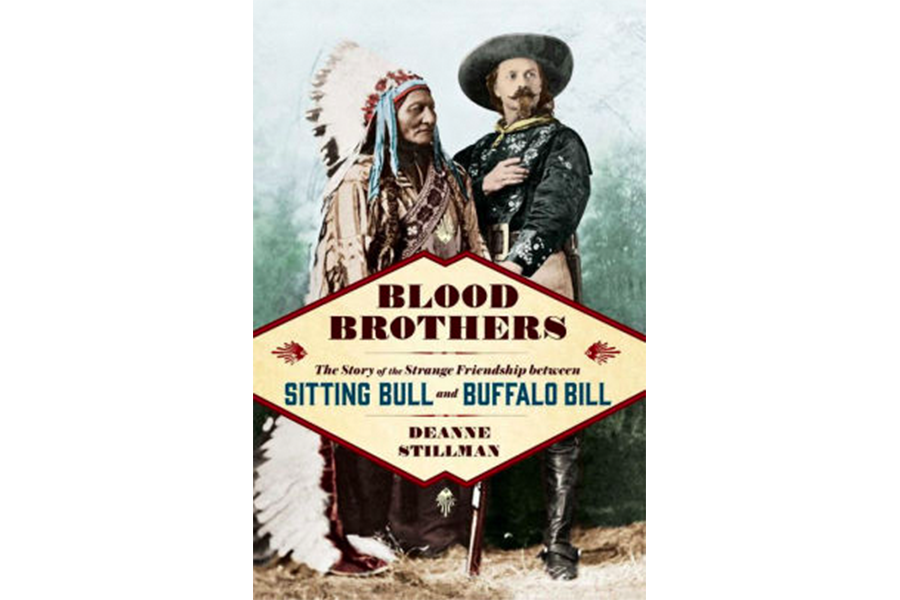'Blood Brothers' details the strange, history-defying friendship of Buffalo Bill and Sitting Bull
Sitting Bull toured with Buffalo Bill Cody’s Wild West show for a four-month period in 1885.

Why, then, did Sitting Bull agree to join the Wild West at all? At that point, after five years of exile in Canada, he was confined to the Standing Rock reservation in South Dakota for his role in Little Bighorn. He saw traveling the country with Buffalo Bill as his best opportunity to meet the American president, a desire he had long harbored, and to otherwise press the case for Indian rights.
Blood Brothers By Deanne Stillman Simon & Schuster 304 pp.
October 26, 2017
By Barbara Spindel
Buffalo Bill Cody’s Wild West toured the world for three decades beginning in 1883, but as Deanne Stillman notes in her intriguing new book, Blood Brothers: The Story of the Strange Friendship between Sitting Bull and Buffalo Bill, the traveling show was most successful during the four-month period in 1885 that Sitting Bull appeared with the troupe. The Hunkpapa Lakota Sioux chief, mistakenly believed by many Americans to have killed George Armstrong Custer at the Battle of the Little Bighorn in 1876, was “the one Indian whose fame was as great as Buffalo Bill’s,” Stillman observes. “Foes in ’76, Friends in ’85” read the caption of the publicity photo of Cody and Sitting Bull that announced the curious collaboration.
Cody’s Wild West was a frontier extravaganza that mythologized America’s recent bloody history, casting white men as the heroes and Indians as the villains. Stillman calls the show, whose climax was a dramatization of Custer’s Last Stand, “an epic spectacle of a vanishing America.” Its creator was many things at once, including buffalo hunter, cowboy, army scout, showman, entrepreneur, and all-around charmer, and "Blood Brothers" brings Buffalo Bill wonderfully to life. His personality, Stillman writes, was “much like the frontier that shaped him – big, exciting, dangerous, with a heart that was elusive and wild.”
In addition, Cody knew how to package himself for the masses. He was so conscious of his entertainment value that, according to Stillman, he once dressed for battle in a “black velvet vaquero outfit, bedecked with lace, silver buttons, and scarlet ribbon,” so that he could don the costume during future performances and truthfully say that he had worn it when he fought the Indians.
While Sitting Bull is more difficult to decipher – he didn’t, after all, have a publicist in his employ – he too was adept at using celebrity to his advantage. He was the Wild West’s highest-paid performer, despite the fact that his role in the show consisted solely of circling the stage gravely on his horse, often as the audience heckled him. He made sure that his contract stipulated that only he could profit from the sale of his photograph and autograph. Still, he gave most of the money away, to friends, relatives, and strangers.
Why, then, did Sitting Bull agree to join the Wild West at all? At that point, after five years of exile in Canada, he was confined to the Standing Rock reservation in South Dakota for his role in Little Bighorn. He saw traveling the country with Buffalo Bill as his best opportunity to meet the American president, a desire he had long harbored, and to otherwise press the case for Indian rights. (Stillman says it’s possible that he met Grover Cleveland during the tour, but the record is unclear.)
October 26, 2017
By Barbara Spindel
Buffalo Bill Cody’s Wild West toured the world for three decades beginning in 1883, but as Deanne Stillman notes in her intriguing new book, Blood Brothers: The Story of the Strange Friendship between Sitting Bull and Buffalo Bill, the traveling show was most successful during the four-month period in 1885 that Sitting Bull appeared with the troupe. The Hunkpapa Lakota Sioux chief, mistakenly believed by many Americans to have killed George Armstrong Custer at the Battle of the Little Bighorn in 1876, was “the one Indian whose fame was as great as Buffalo Bill’s,” Stillman observes. “Foes in ’76, Friends in ’85” read the caption of the publicity photo of Cody and Sitting Bull that announced the curious collaboration.
Cody’s Wild West was a frontier extravaganza that mythologized America’s recent bloody history, casting white men as the heroes and Indians as the villains. Stillman calls the show, whose climax was a dramatization of Custer’s Last Stand, “an epic spectacle of a vanishing America.” Its creator was many things at once, including buffalo hunter, cowboy, army scout, showman, entrepreneur, and all-around charmer, and "Blood Brothers" brings Buffalo Bill wonderfully to life. His personality, Stillman writes, was “much like the frontier that shaped him – big, exciting, dangerous, with a heart that was elusive and wild.”
In addition, Cody knew how to package himself for the masses. He was so conscious of his entertainment value that, according to Stillman, he once dressed for battle in a “black velvet vaquero outfit, bedecked with lace, silver buttons, and scarlet ribbon,” so that he could don the costume during future performances and truthfully say that he had worn it when he fought the Indians.
Why, then, did Sitting Bull agree to join the Wild West at all? At that point, after five years of exile in Canada, he was confined to the Standing Rock reservation in South Dakota for his role in Little Bighorn. He saw traveling the country with Buffalo Bill as his best opportunity to meet the American president, a desire he had long harbored, and to otherwise press the case for Indian rights. (Stillman says it’s possible that he met Grover Cleveland during the tour, but the record is unclear.)
No comments:
Post a Comment